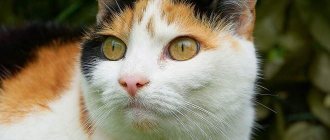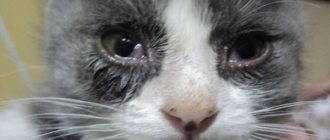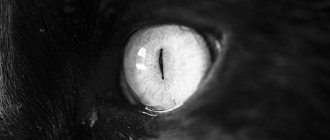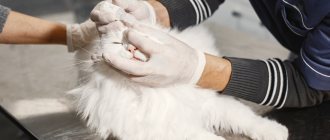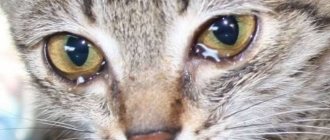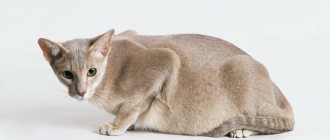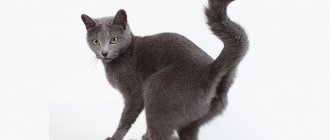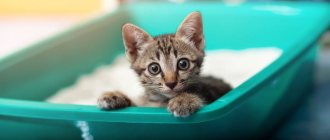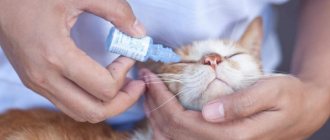For normal functioning of the organs of vision, the anterior surface of the eyeball of mammals must always be well moistened. This task is performed by the lacrimal apparatus. A cat's lacrimal glands constantly secrete a small amount of tear fluid, which has a protective and disinfectant function. The waste moisture goes into the so-called lacrimal lake, which communicates with anatomical structures - lacrimal openings. These are small holes in the corners of the eyes that lead into the tear ducts. Through them, moisture flows into the nasal cavity and evaporates under the influence of breathing.
If the animal is healthy, then there is practically no excess tear fluid. There is no discharge from the cat's eyes at all. A small amount of transparent liquid secretion may be released, which is practically invisible from the outside and does not require elimination.
If the discharge is copious, opaque, has an unpleasant odor and color, it can be assumed that there is an eye pathology. White, green, reddish, brown discharge indicates a bacterial or fungal infection. Let's look at why this happens, let's look at the main causes of pathological discharge from the eyes, find out how to treat the animal, what first aid measures are.
Normal eye discharge
In most cases, cats have slightly wet, shiny eyes. The lacrimal glands secrete secretions to moisturize the mucous membranes. This helps clean the outside, prevents drying out and provides some protection from damage. Cats' eyes do not normally run, but they may release a small amount of fluid when they encounter irritants. Bright light, dust, wind or cigarette smoke can act as a provocateur.
Periodic lacrimation is observed in brachycephalics. In cats with flattened faces, the functioning of the glands and the outflow of fluid are disrupted after a long stay in a horizontal position or on the side. Animals with large bulging eyes are more susceptible to infectious inflammation and external factors, since their organs are less protected by skin folds. The risk group includes Persian and Scottish cats, exotics, bobtails, etc. Representatives of these breeds and mestizos, which have inherited specific traits, require careful care and removal of discharge.
The main types of pathological discharge from the eyes
Excessive tearing is not normal, even if the liquid is clear. In case of diseases and injuries in pets, the following main types of pathological discharges can be detected:
- Transparent liquid of normal consistency. A sign of involuntary lacrimation. May occur as a result of injury or in the early stages of disease. Transparent color and liquid consistency indicate the absence of infection. With insufficient hygiene, tears can oxidize and turn into brown crusts, but initially there is no bright shade.
- White mucous discharge. Occurs at the initial stage of inflammation. At this time, it is most often possible to quickly suppress the disease with timely and adequate treatment.
- Greenish or yellow thick discharge. Appear in the last stages of infectious infection. The color indicates the presence of pus. Most often, such discharge is accompanied by general weakness, fever and a state of intoxication. Without help, the animal may lose an eye. Possible death.
- Thick brown or black discharge from your cat's eyes. The hue indicates the presence of red blood cells in the liquid. An increased concentration of red blood cells may be associated with a violation of the anatomical position of the ducts or improper outflow of fluid. Sometimes brown discharge appears in the later stages of infectious diseases if pathogens have penetrated the choroid.
Brown discharge may occur in brachycephalic breeds and breeds with protruding eyes. Conventionally, this sign is sometimes considered normal, but it is advisable to visit a veterinarian for analysis and identification of pathogenic microflora.
DISCHARGE FROM THE EYES IN CATS // Network of Veterinary Clinics BIO-VET
Causes
The appearance of dark discharge and brown crusts around a cat's eyes may be due to a violation of the outflow of fluid through the tear ducts or infectious diseases.
Impaired outflow of tear fluid through the nasolacrimal duct (dacryocystitis)
The development of the disease can occur for several reasons:
- Inflammatory processes. Due to diseases of the eyes and neighboring tissues, swelling occurs. This leads to narrowing of the tear ducts and difficulty in fluid circulation.
- Stenosis of lacrimal openings. Narrowing most often occurs as a result of chronic infectious lesions. Stenosis is accompanied by constant lacrimation.
- Blockage by a foreign body. Small debris can get into the ducts and cause inflammation. Later, infection may occur.
- Mechanical injury. If the canals are damaged, black or brown discharge from the eyes of cats is observed. The color is due to the presence of bloody impurities.
- Neoplasms in the lacrimal glands or adjacent tissues. Tumors cause mechanical narrowing of the ducts. With the simultaneous destruction of tissue, blood appears in the secretions. The color turns red or brown.
Infectious inflammation of various areas of the eye structures
There are several forms of infectious lesions of the organs of vision:
- Blepharitis. Inflammation of eyelash bulbs. The owner may think that the cat has dirt in its eyes. Discharge accumulates in the corners. They may be grayish or brown in color.
- Conjunctivitis. Damage to the mucous membrane, which is accompanied by swelling of the eyelids, redness and the appearance of purulent discharge. In later stages, cats are unable to open their eyes due to crusts.
- Keratitis. Corneal damage. Most often, the disease develops due to mechanical trauma and infection. Pathology is accompanied by the formation of a pathological infiltrate. When deep vessels are affected, the discharge becomes dark in color.
- Iridocyclitis. Inflammation of the choroid. Photophobia is observed in animals. Cats may wash or rub their eyes thoroughly due to pain. First, profuse lacrimation occurs, and later a pathological infiltrate is released.
Brown exudate in cats
The health of a mustachioed pet is judged by the condition of its mucous membranes. Excessive suppuration from the nose or eyes indicates abnormalities in health.
Eye diseases often lead to the appearance of brown fluid in the corners of the eyes - this is an alarming symptom.
The animal becomes restless, its fur thins, becomes dull, and its appetite worsens..
Such signs indicate that an infection is developing in the animal’s body, and urgent measures must be taken.
Treatment of the disease
If you have a question about how to treat your cat, you need to contact the clinic. The doctor will examine and interview the animal owner. Fluid may be collected from the tear glands for testing. This allows you to identify the strain of bacteria and select an effective drug. Depending on the causes of the disease, anti-inflammatory drugs and antibiotics can be used. In advanced cases, surgery is performed. Surgery may involve removing the eye, widening the tear ducts, removing a foreign object, etc.
If visiting a veterinarian is not possible, you can administer first aid to improve the condition yourself. It is recommended to use chamomile decoction for rinsing. It is prepared from pharmaceutical raw materials and distilled water. It is important to use clean liquid, otherwise the eye may become infected.
For rinsing you will need a cotton pad. It is recommended not to use gauze or standard cotton wool, as particles may remain on the surface. Rough fabric can damage delicate mucous membranes. A cotton pad is moistened in the liquid and gently wiped from the inner corner to the outer corner. If there are crusts, do not roughly remove them. You should soak the accumulations, then try to carefully remove them.
Both eyes need to be treated. A separate swab is used for each to prevent transmission of infection. It is allowed to use antibacterial solutions for treatment after permission from a veterinarian.
First aid
For any of the diseases described above, we would advise immediately contacting a veterinarian. But before a specialist’s visit, you can help the animal:
- The cat should be placed in a semi-dark, well-ventilated room without drafts (semi-dark - so as not to force the pet to close its eyes again).
- It is necessary (if the cat is long-haired) to cut off the long hair around the eyes that is stuck together from exudate.
- In addition, the skin and hair around the eyes must be thoroughly cleaned of exudate using a cotton pad and 1% hydrogen peroxide.
Prevention
Prevention consists of monitoring and caring for your pet. Most breeds do not require intervention, however, in the case of cats with flattened faces, it is necessary to remove the discharge when it appears. The natural secretion, when dried and oxidized, forms a good environment for the growth of bacteria. This increases the risk of developing diseases.
Eye diseases in kittens! Herpes of the eye and calicivirus in cats.
To prevent discharge, it is recommended not to give your cat sweets. Animals metabolize sugar worse than humans. Some of the breakdown products enter the bloodstream and cause a reaction from the immune system. This causes discharge from the eyes, itching and redness of the skin.
All information posted on the site is provided in accordance with the User Agreement and is not a direct instruction to action. We strongly recommend that before using any product, you must obtain a face-to-face consultation at an accredited veterinary clinic.
Instructions for use of solutions
To ensure that the animal is not in pain and that the procedure is effective, you need to take a responsible approach to eye rinsing. To do this you need to adhere to the following rules:
- Ask someone for help
. Have one participant wash the eyes while the other holds the animal tightly. - Take a clean cotton swab
. Wet it with solution, decoction or water. - If your pet's eyelids are stuck together
, first gently moisten them with the solution until they open. - Blot sticky eyelashes with a damp swab in the direction from the nose to the corners of the eyes.
- Squeeze the liquid
collected in the tampon into the cat's eye.
Tampons must be wet. Dry cotton wool can further injure the damaged eye. It is better to use warm solutions.
Please note that if your pet has black discharge in his eyes, there is no need to self-medicate. You may harm your cat's health
Contact your veterinarian immediately for a correct diagnosis and treatment.
By nature, cats are given acute vision. This is an important tool for hunting and orientation even in complete darkness. Loss of vision causes deep psychological trauma
It is very important to monitor the condition of your pet’s eyes in order to prevent the development of any diseases in time. There are many factors that cause eye diseases in a cat, and knowledge of the causes, symptoms and ways to overcome the disease will keep the animal healthy
